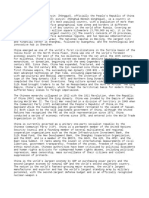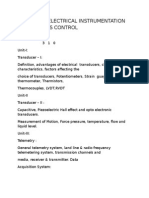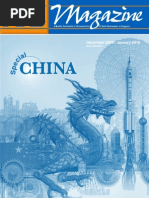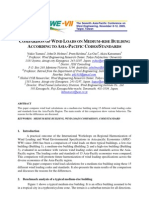0 ratings0% found this document useful (0 votes)
51 viewsChina (China (PRC
China (China (PRC
Uploaded by
Orgito LekaChina is the world's most populous country with over 1.4 billion people. It has a long history as one of the earliest civilizations and was once ruled by a series of dynastic monarchies until the establishment of the People's Republic of China in 1949 led by the Communist Party. While China has experienced rapid economic growth with annual GDP growth over 6% since economic reforms began in 1978, it remains a one-party socialist state that has been criticized for human rights issues.
Copyright:
© All Rights Reserved
Available Formats
Download as DOCX, PDF, TXT or read online from Scribd
China (China (PRC
China (China (PRC
Uploaded by
Orgito Leka0 ratings0% found this document useful (0 votes)
51 views1 pageChina is the world's most populous country with over 1.4 billion people. It has a long history as one of the earliest civilizations and was once ruled by a series of dynastic monarchies until the establishment of the People's Republic of China in 1949 led by the Communist Party. While China has experienced rapid economic growth with annual GDP growth over 6% since economic reforms began in 1978, it remains a one-party socialist state that has been criticized for human rights issues.
Original Title
China
Copyright
© © All Rights Reserved
Available Formats
DOCX, PDF, TXT or read online from Scribd
Share this document
Did you find this document useful?
Is this content inappropriate?
China is the world's most populous country with over 1.4 billion people. It has a long history as one of the earliest civilizations and was once ruled by a series of dynastic monarchies until the establishment of the People's Republic of China in 1949 led by the Communist Party. While China has experienced rapid economic growth with annual GDP growth over 6% since economic reforms began in 1978, it remains a one-party socialist state that has been criticized for human rights issues.
Copyright:
© All Rights Reserved
Available Formats
Download as DOCX, PDF, TXT or read online from Scribd
Download as docx, pdf, or txt
0 ratings0% found this document useful (0 votes)
51 views1 pageChina (China (PRC
China (China (PRC
Uploaded by
Orgito LekaChina is the world's most populous country with over 1.4 billion people. It has a long history as one of the earliest civilizations and was once ruled by a series of dynastic monarchies until the establishment of the People's Republic of China in 1949 led by the Communist Party. While China has experienced rapid economic growth with annual GDP growth over 6% since economic reforms began in 1978, it remains a one-party socialist state that has been criticized for human rights issues.
Copyright:
© All Rights Reserved
Available Formats
Download as DOCX, PDF, TXT or read online from Scribd
Download as docx, pdf, or txt
You are on page 1of 1
China (Chinese: 中国; pinyin: Zhōngguó; literally: 'Central State'), officially the People's Republic of
China (PRC; Chinese: 中华人民共和国; pinyin: Zhōnghuá Rénmín Gònghéguó), is a country in East
Asia. It is the world's most populous country, with a population of around 1.428 billion in 2017.
Covering approximately 9,600,000 square kilometers (3,700,000 sq mi), it is the world's third or
fourth largest country by area.[j] Governed by the Communist Party of China, the state exercises
jurisdiction over 22 provinces,[k] five autonomous regions, four direct-controlled
municipalities (Beijing, Tianjin, Shanghai, and Chongqing), and the special administrative
regions of Hong Kong and Macau.
China emerged as one of the world's first civilizations, in the fertile basin of the Yellow River in
the North China Plain. For millennia, China's political system was based on hereditary monarchies,
or dynasties, beginning with the semi-mythical Xia dynasty in 21st century BCE. Since then, China
has expanded, fractured, and re-unified numerous times. In the 3rd century BCE, the Qin reunited
core China and established the first Chinese empire. The succeeding Han dynasty, which ruled from
206 BCE until 220 CE, saw some of the most advanced technology at that time,
including papermaking and the compass, along with agricultural and medical improvements. The
invention of gunpowder and movable type in the Tang dynasty (618–907) and Northern Song (960–
1127) completed the Four Great Inventions. Tang culture spread widely in Asia, as the new Silk
Route brought traders to as far as Mesopotamia and the Horn of Africa. Dynastic rule ended in 1912
with the Xinhai Revolution, when the Republic of China (ROC) replaced the Qing dynasty. China, as
a whole, was ravaged by feudal warlordism and Japan during World War II. The
subsequent Chinese Civil War resulted in a division of territory in 1949 when the Communist Party of
China led by Mao Zedong established the People's Republic of China on mainland China while
the Kuomintang-led nationalist government retreated to the island of Taiwan where it governed until
1996 when Taiwan transitioned to democracy. The political status of Taiwan remains disputed to this
day.
China is a unitary one-party socialist republic and is one of the few existing socialist states. Political
dissidents and human rights groups have denounced and criticized the Chinese
government for human rights abuses, suppression of religious and ethnic
minorities, censorship and mass surveillance, and cracking down on protests such as in 1989. The
Chinese government says that the right to subsistence and economic development is a prerequisite
to other types of human rights and that the notion of human rights should take into account a
country's present economic level.
Since the introduction of economic reforms in 1978, China's economy has been one of the
world's fastest-growing with annual growth rates consistently above 6 percent. According to the
World Bank, China's GDP grew from $150 billion in 1978 to $12.24 trillion by 2017. According to
official data, China's GDP in 2018 was 90 trillion Yuan ($13.5 trillion). Since 2010, China has been
the world's second-largest economy by nominal GDP, and since 2014, the largest economy in the
world by PPP. China is also the world's largest exporter and second-largest importer of goods. China
is a recognized nuclear weapons state and has the world's largest standing army, the People's
Liberation Army, and the second-largest defense budget. The PRC is a permanent member of
the United Nations Security Council as it replaced the ROC in 1971, as well as an active global
partner of ASEAN Plus mechanism. China has been characterized as a emerging superpower,
mainly because of its massive population, large and rapidly-growing economy, and powerful military.
You might also like
- State-Led Chinese Nationalism - An Analysis of Primary School TextbooksDocument23 pagesState-Led Chinese Nationalism - An Analysis of Primary School TextbooksMykola UstichNo ratings yet
- Analysis of A Miracle ChinaDocument6 pagesAnalysis of A Miracle ChinaPhranxies Jean Loay BlayaNo ratings yet
- How To Make Money On YouTubeDocument39 pagesHow To Make Money On YouTubeOrgito Leka75% (4)
- Invisible Women: Contemporary Chinese Film and Women's CinemaDocument26 pagesInvisible Women: Contemporary Chinese Film and Women's CinemalanzhoucityNo ratings yet
- 7a AnandDocument3 pages7a AnandNomunbileg KhNo ratings yet
- China (: Zhōngguó Lit. "Middle Kingdom" or "Central State"), OfficiallyDocument1 pageChina (: Zhōngguó Lit. "Middle Kingdom" or "Central State"), OfficiallyJoshua WacanganNo ratings yet
- Marele Zid Chinezesc 2021Document1 pageMarele Zid Chinezesc 2021Frasie SergiuNo ratings yet
- ChinaDocument2 pagesChinaMarius CiobanuNo ratings yet
- China (China (PRCDocument1 pageChina (China (PRCMaui ShihtzuNo ratings yet
- China (China (PRC) (ChineseDocument1 pageChina (China (PRC) (ChineseRadhika PrasadNo ratings yet
- China: (CITATION Wik1 /L 1048)Document2 pagesChina: (CITATION Wik1 /L 1048)Florentina IvanNo ratings yet
- ChinaDocument1 pageChinaNokkiko EieiNo ratings yet
- China, Officially The People's Republic of China (PRC), Is ADocument1 pageChina, Officially The People's Republic of China (PRC), Is AHello BabyNo ratings yet
- ChinaDocument2 pagesChinaSAI CHAITANYA YEPURINo ratings yet
- Research On COVIDDocument2 pagesResearch On COVIDdivya kashyapNo ratings yet
- ChinaDocument1 pageChinaplayingpiano2100No ratings yet
- WikiDocument1 pageWikiJasonNo ratings yet
- China, Officially The People's Republic of China (PRC), in Asia, Is The World'sDocument1 pageChina, Officially The People's Republic of China (PRC), in Asia, Is The World'sBishwo KhatriNo ratings yet
- ChinaDocument3 pagesChinaplayingpiano2100No ratings yet
- ChinaDocument5 pagesChinaabhishekkr26jNo ratings yet
- COUNTRY AND TOPIC RESEARCH Ilyas BagdatovDocument5 pagesCOUNTRY AND TOPIC RESEARCH Ilyas BagdatovIlyas BagdatovNo ratings yet
- Chinese Pols Exam 1 Review SheetDocument9 pagesChinese Pols Exam 1 Review Sheetlyingsok3No ratings yet
- Cina PPWDocument7 pagesCina PPWemma cabizzaNo ratings yet
- Today'S China: The Emerging Superpower Executive SummaryDocument9 pagesToday'S China: The Emerging Superpower Executive SummaryMuhammad Umar KhanNo ratings yet
- China: Background InformationDocument2 pagesChina: Background InformationAmanda Amelia MendesNo ratings yet
- EP ChinaDocument1 pageEP ChinaShivani KambleNo ratings yet
- ChinaDocument2 pagesChinaCristiana TemelieNo ratings yet
- ChinaDocument2 pagesChinathehorseoftokyoNo ratings yet
- China DictatorshipDocument3 pagesChina DictatorshipDaminNo ratings yet
- Essay On ChinaDocument1 pageEssay On ChinaAbhishekNo ratings yet
- The Person Behind The Reforms: Deng XiaopingDocument4 pagesThe Person Behind The Reforms: Deng XiaopingMalini JwalaNo ratings yet
- China (China (PRCDocument1 pageChina (China (PRCattilatothNo ratings yet
- China Constitution - PreambleDocument2 pagesChina Constitution - PreambleCamille LopezNo ratings yet
- Constitution of People's Republic of ChinaDocument7 pagesConstitution of People's Republic of China3u8ih1o7No ratings yet
- China Economy Overview China IntrodutionDocument6 pagesChina Economy Overview China IntrodutionDamian CarlaNo ratings yet
- China (Republic of China (PRC), Is ADocument1 pageChina (Republic of China (PRC), Is ACorina Taraș-LunguNo ratings yet
- Topic 5: Political InstitutionDocument11 pagesTopic 5: Political InstitutionMondrich GabrienteNo ratings yet
- International Marketing: Submitted To: Dr. (Prof.) D. DaveDocument61 pagesInternational Marketing: Submitted To: Dr. (Prof.) D. DaveAagam ShahNo ratings yet
- China - Wikipedia1Document20 pagesChina - Wikipedia1manandpatelNo ratings yet
- China Government PDFDocument15 pagesChina Government PDFabhijeet nafriNo ratings yet
- C I N ADocument9 pagesC I N AMahfudNo ratings yet
- History: China, Officially The People's Republic of China (PRC), Is ADocument2 pagesHistory: China, Officially The People's Republic of China (PRC), Is AjmaroseguitarteNo ratings yet
- NO COMMUNISTS Wikipedia Democratic Federation of ChinaDocument58 pagesNO COMMUNISTS Wikipedia Democratic Federation of Chinahazelfaras333No ratings yet
- China and DemocracyDocument8 pagesChina and DemocracyGovind ParmarNo ratings yet
- China ReportDocument25 pagesChina ReportUzairNo ratings yet
- China, Officially The People's Republic of China (PRC), Is ADocument1 pageChina, Officially The People's Republic of China (PRC), Is ARam Krishna AdhikariNo ratings yet
- Country Profile ChinaDocument23 pagesCountry Profile Chinaa78ryNo ratings yet
- Mod 15 ChinaDocument26 pagesMod 15 ChinaPatrick CruzNo ratings yet
- Navneet's Ibm AssignmentDocument16 pagesNavneet's Ibm AssignmentNavneet KumarNo ratings yet
- China Country ProfileDocument6 pagesChina Country Profileapi-98469116No ratings yet
- China ReportDocument17 pagesChina ReportAlhaina JulkanainNo ratings yet
- CICM MISSION (Dont Print)Document4 pagesCICM MISSION (Dont Print)Christian FloresNo ratings yet
- China As An Emerging Politico-Economic Power SuperpowerDocument12 pagesChina As An Emerging Politico-Economic Power SuperpowerRehman Khan JatoiNo ratings yet
- CHINADocument78 pagesCHINAUinNo ratings yet
- ChinaDocument101 pagesChinaShairuz Caesar Briones DugayNo ratings yet
- China: LocationDocument6 pagesChina: Locationakshara pradeepNo ratings yet
- Civil and Commercial Laws / Civil Procedure Law of the People's Republic of China: Laws and Regulations of the People's Republic of ChinaFrom EverandCivil and Commercial Laws / Civil Procedure Law of the People's Republic of China: Laws and Regulations of the People's Republic of ChinaNo ratings yet
- A Deeper Look at ChinaDocument9 pagesA Deeper Look at ChinaphamhaithiendinhNo ratings yet
- How Communist Party Operates in Chinese Society: Victoria CGA 2013059087Document2 pagesHow Communist Party Operates in Chinese Society: Victoria CGA 2013059087Victoria VCNo ratings yet
- The Finest China Take A Trip Suggestions.20140820.202520Document2 pagesThe Finest China Take A Trip Suggestions.20140820.202520germansoup97No ratings yet
- China'S Foreign PolicyDocument20 pagesChina'S Foreign PolicyshahzaibNo ratings yet
- China Russia RelationsDocument22 pagesChina Russia RelationsYassine Afilal Elalami IdrissiNo ratings yet
- Universal Values in Engaging With BeijingDocument5 pagesUniversal Values in Engaging With BeijingHoward39No ratings yet
- Top 10 Banks in The WorldDocument4 pagesTop 10 Banks in The WorldOrgito LekaNo ratings yet
- Albania (Albania (: A (W) L - Nee-ƏDocument1 pageAlbania (Albania (: A (W) L - Nee-ƏOrgito LekaNo ratings yet
- Banksia Speciosa, Commonly Known As The Showy Banksia, Is A Species of Large Shrub or SmallDocument3 pagesBanksia Speciosa, Commonly Known As The Showy Banksia, Is A Species of Large Shrub or SmallOrgito LekaNo ratings yet
- Kosovo (Kosovo (: Pronounced Pronounced PronouncedDocument1 pageKosovo (Kosovo (: Pronounced Pronounced PronouncedOrgito LekaNo ratings yet
- China: Numeral System or Binary Numeral System, Which Uses Only Two Symbols: Typically "0" (Document2 pagesChina: Numeral System or Binary Numeral System, Which Uses Only Two Symbols: Typically "0" (Orgito LekaNo ratings yet
- Française,: France (Document1 pageFrançaise,: France (Orgito LekaNo ratings yet
- Germany (Germany (German: Bundesrepublik DeutschlandDocument1 pageGermany (Germany (German: Bundesrepublik DeutschlandOrgito LekaNo ratings yet
- Mario Game Has Been Released For Every Major NintendoDocument5 pagesMario Game Has Been Released For Every Major NintendoOrgito LekaNo ratings yet
- North Macedonia: Macedonia and FYROM) - in June 2018, Macedonia and Greece Resolved The Dispute WithDocument1 pageNorth Macedonia: Macedonia and FYROM) - in June 2018, Macedonia and Greece Resolved The Dispute WithOrgito LekaNo ratings yet
- North Macedonia: Macedonia and FYROM) - in June 2018, Macedonia and Greece Resolved The Dispute WithDocument1 pageNorth Macedonia: Macedonia and FYROM) - in June 2018, Macedonia and Greece Resolved The Dispute WithOrgito LekaNo ratings yet
- Edward Thomas Hardy (Born 15 September 1977) Is An English Actor and ProducerDocument2 pagesEdward Thomas Hardy (Born 15 September 1977) Is An English Actor and ProducerOrgito LekaNo ratings yet
- Interjections in Taiwan Mandarin: Myrthe KroonDocument56 pagesInterjections in Taiwan Mandarin: Myrthe KroonRaoul ZamponiNo ratings yet
- Eee - 504: Electrical Instrumentation and Process ControlDocument8 pagesEee - 504: Electrical Instrumentation and Process Controlsaniaiqbal6No ratings yet
- Koert Working Experience in China - Page 15/16Document40 pagesKoert Working Experience in China - Page 15/16koertb3167No ratings yet
- FT UsDocument20 pagesFT UsHermeson MenesesNo ratings yet
- Top 10 Most Visited Asian CountriesDocument2 pagesTop 10 Most Visited Asian Countriesg oNo ratings yet
- Torch Lighters Gladys Aylward LeaderDocument20 pagesTorch Lighters Gladys Aylward LeaderAle Ranghiuc100% (1)
- Keeping The Pacific PacificDocument4 pagesKeeping The Pacific PacificuniexchangeNo ratings yet
- 马华文学Document0 pages马华文学Ang AngelineNo ratings yet
- World History Asia VocabDocument6 pagesWorld History Asia VocabDylan DaytonNo ratings yet
- IBR2012 - Women in Senior ManagementDocument12 pagesIBR2012 - Women in Senior ManagementDinos MarcouNo ratings yet
- Design Wind Speeds Diffrent 3 Sec 1 Hour MeanDocument8 pagesDesign Wind Speeds Diffrent 3 Sec 1 Hour MeanAkhilesh Krishna RamkalawonNo ratings yet
- Transnational Performance, Identity and Mobility in Asia: Iris H. Tuan and Ivy I-Chu ChangDocument177 pagesTransnational Performance, Identity and Mobility in Asia: Iris H. Tuan and Ivy I-Chu ChangAigasaki NakanoNo ratings yet
- Chinese Communist Revolution Worksheet PacketDocument6 pagesChinese Communist Revolution Worksheet Packetcreyes25No ratings yet
- Thayer Australia's Strategic Outlook: Submission To The 2013 Defence White PaperDocument7 pagesThayer Australia's Strategic Outlook: Submission To The 2013 Defence White PaperCarlyle Alan ThayerNo ratings yet
- Taiwan Tourist Visa Application PDFDocument4 pagesTaiwan Tourist Visa Application PDFPark LeeNo ratings yet
- Imp of SCSDocument6 pagesImp of SCSadityaNo ratings yet
- BKPM PPT Presentation Press Release Q II 2015 PDFDocument37 pagesBKPM PPT Presentation Press Release Q II 2015 PDFdenankaligisNo ratings yet
- cc13 LowresDocument182 pagescc13 LowreshndndzNo ratings yet
- Mineral Supply and Demand Into The 21st Century: by Stephen E. KeslerDocument8 pagesMineral Supply and Demand Into The 21st Century: by Stephen E. KeslerWawin PrabawaNo ratings yet
- Robotics in FutureDocument4 pagesRobotics in FutureThomson JosephNo ratings yet
- Sexuality in Chinese CultureDocument10 pagesSexuality in Chinese Culturemshek17No ratings yet
- Essay Writing On TaiwanDocument9 pagesEssay Writing On TaiwanPraveen KumarNo ratings yet
- Silicon TriangleDocument9 pagesSilicon Trianglealvezthiago2No ratings yet
- Thayer China's Joint Sword 2024A Military Exercise - A Dress Rehearsal For An Invasion of TaiwanDocument2 pagesThayer China's Joint Sword 2024A Military Exercise - A Dress Rehearsal For An Invasion of TaiwanCarlyle Alan ThayerNo ratings yet
- I-Kuan Tao 一貫道 (The Way Of Unity) : The Emerging Folk Buddhism In China And TaiwanDocument17 pagesI-Kuan Tao 一貫道 (The Way Of Unity) : The Emerging Folk Buddhism In China And TaiwanrobertotelesNo ratings yet
- Download Full Made in Taiwan Studies in Popular Music 1st Edition Eva Tsai PDF All ChaptersDocument75 pagesDownload Full Made in Taiwan Studies in Popular Music 1st Edition Eva Tsai PDF All Chapterswailonriro100% (6)
- S/N Tab Name Information RemarksDocument129 pagesS/N Tab Name Information RemarksJasmine AngNo ratings yet
- China in Latin America: Hegemonic Challenge?: by Isabel HiltonDocument5 pagesChina in Latin America: Hegemonic Challenge?: by Isabel HiltonKevin LiNo ratings yet





































































































